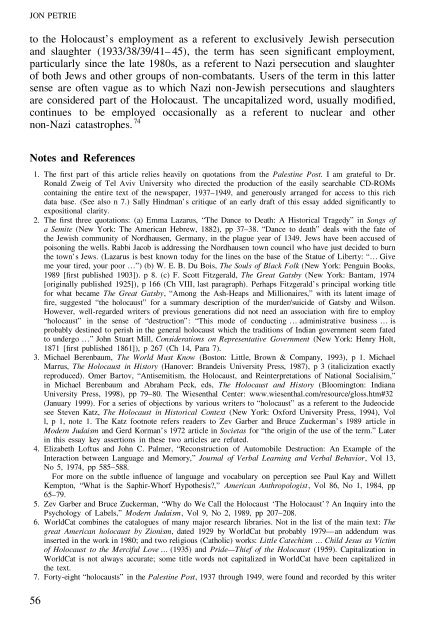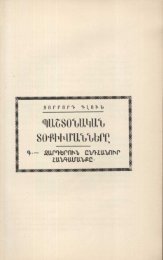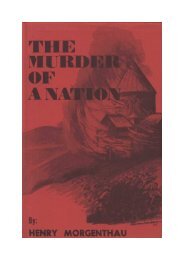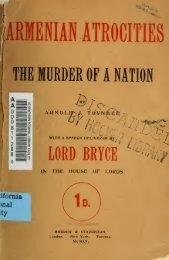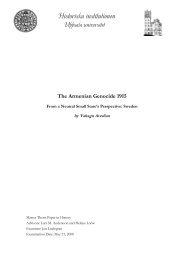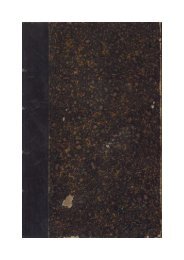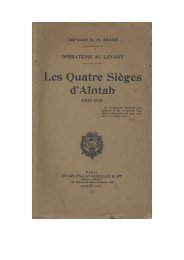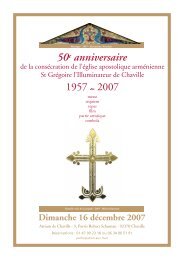JON PETRIEto the Holocaust’s employment as a referent to exclusively Jewish persecution<strong>and</strong> slaughter (1933/38/39/41– 45), the term has seen signi cant employment,particularly since the late 1980s, as a referent to Nazi persecution <strong>and</strong> slaughterof both Jews <strong>and</strong> other groups of non-combatants. Users of the term in this lattersense are often vague as to which Nazi non-Jewish persecutions <strong>and</strong> slaughtersare considered part of the Holocaust. <strong>The</strong> uncapitalized <strong>word</strong>, usually modi ed,continues to be employed occasionally as a referent to nuclear <strong>and</strong> othernon-Nazi catastrophes. 74Notes <strong>and</strong> References1. <strong>The</strong> rst part of this article relies heavily on quotations from the Palestine Post. I am grateful to Dr.Ronald Zweig of Tel Aviv University who directed the production of the easily searchable CD-ROMscontaining the entire text of the newspaper, 1937–1949, <strong>and</strong> generously arranged for access to this richdata base. (See also n 7.) Sally Hindman’s critique of an early draft of this essay added signi cantly toexpositional clarity.2. <strong>The</strong> rst three quotations: (a) Emma Lazarus, “<strong>The</strong> Dance to Death: A Historical Tragedy” in Songs ofa Semite (New York: <strong>The</strong> American Hebrew, 1882), pp 37–38. “Dance to death” deals with the fate ofthe Jewish community of Nordhausen, Germany, in the plague year of 1349. Jews have been accused ofpoisoning the wells. Rabbi Jacob is addressing the Nordhausen town council who have just decided to burnthe town’s Jews. (Lazarus is best known today for the lines on the base of the Statue of Liberty: “… Giveme your tired, your poor …”) (b) W. E. B. Du Bois, <strong>The</strong> Souls of Black Folk (New York: Penguin Books,1989 [ rst published 1903]). p 8. (c) F. Scott Fitzgerald, <strong>The</strong> Great Gatsby (New York: Bantam, 1974[originally published 1925]), p 166 (Ch VIII, last paragraph). Perhaps Fitzgerald’s principal working titlefor what became <strong>The</strong> Great Gatsby, “Among the Ash-Heaps <strong>and</strong> Millionaires,” with its latent image of re, suggested “the holocaust” for a summary description of the murder/suicide of Gatsby <strong>and</strong> Wilson.However, well-regarded writers of previous generations did not need an association with re to employ“holocaust” in the sense of “destruction”: “This mode of conducting … administrative business … isprobably destined to perish in the general holocaust which the traditions of Indian government seem fatedto undergo …” John Stuart Mill, Considerations on Representative Government (New York: Henry Holt,1871 [ rst published 1861]), p 267 (Ch 14, Para 7).3. Michael Berenbaum, <strong>The</strong> World Must Know (Boston: Little, Brown & Company, 1993), p 1. MichaelMarrus, <strong>The</strong> Holocaust in History (Hanover: Br<strong>and</strong>eis University Press, 1987), p 3 (italicization exactlyreproduced). Omer Bartov, “Antisemitism, the Holocaust, <strong>and</strong> Reinterpretations of National Socialisim,”in Michael Berenbaum <strong>and</strong> Abraham Peck, eds, <strong>The</strong> Holocaust <strong>and</strong> History (Bloomington: IndianaUniversity Press, 1998), pp 79–80. <strong>The</strong> Wiesenthal Center: www.wiesenthal.com/resource/gloss.htm#32(January 1999). For a series of objections by various writers to “holocaust” as a referent to the Judeocidesee Steven Katz, <strong>The</strong> Holocaust in Historical Context (New York: Oxford University Press, 1994), Voll, p 1, note 1. <strong>The</strong> Katz footnote refers readers to Zev Garber <strong>and</strong> Bruce Zuckerman’s 1989 article inModern Judaism <strong>and</strong> Gerd Korman’s 1972 article in Societas for “the origin of the use of the term.” Laterin this essay key assertions in these two articles are refuted.4. Elizabeth Loftus <strong>and</strong> John C. Palmer, “Reconstruction of Automobile Destruction: An Example of theInteraction between Language <strong>and</strong> Memory,” Journal of Verbal Learning <strong>and</strong> Verbal Behavior, Vol 13,No 5, 1974, pp 585–588.For more on the subtle in uence of language <strong>and</strong> vocabulary on perception see Paul Kay <strong>and</strong> WillettKempton, “What is the Saphir-Whorf Hypothesis?,” American Anthropologist, Vol 86, No 1, 1984, pp65–79.5. Zev Garber <strong>and</strong> Bruce Zuckerman, “Why do We Call the Holocaust ‘<strong>The</strong> Holocaust’? An Inquiry into thePsychology of Labels,” Modern Judaism, Vol 9, No 2, 1989, pp 207–208.6. WorldCat combines the catalogues of many major research libraries. Not in the list of the main text: <strong>The</strong>great American holocaust by Zionism, dated 1929 by WorldCat but probably 1979—an addendum wasinserted in the work in 1980; <strong>and</strong> two religious (Catholic) works: Little Catechism … Child Jesus as Victimof Holocaust to the Merciful Love … (1935) <strong>and</strong> Pride—Thief of the Holocaust (1959). Capitalization inWorldCat is not always accurate; some title <strong>word</strong>s not capitalized in WorldCat have been capitalized inthe text.7. Forty-eight “holocausts” in the Palestine Post, 1937 through 1949, were found <strong>and</strong> recorded by this writer56
THE SECULAR WORD <strong>HOLOCAUST</strong>using the easily searchable CD-ROMs produced under the direction of Dr. Ronald Zweig, director of TelAviv University’s Humanities Computing Project. (See also n 1.)8. <strong>The</strong> 1910–1950 dates were chosen to exclude: “<strong>The</strong> days of the Black Death <strong>and</strong> the Crusades are againupon us … In one Russian town … we are informed by an eyewitness, there was a holocaust of Jewishsouls, <strong>and</strong> the martyrs went singing to their doom. Does it not recall the tragedies of the Dark Ages, whenthe children of Israel, led to slaughter, perished ‘as consecrated hosts of the Lord’ …” (George Kohut, ina preface to a 1907 edition of Zunz’s Sufferings of the Jews in the Middle Ages, as cited in JosephLeftwich, <strong>The</strong> Golden Peacock: A Worldwide Treasury of Yiddish Poetry (New York: T. Yoseloff, 1961),p 22). Some might see Kohut’s 1907 “holocaust” as carrying religious/sacri cial overtones, hence my1910–1950 dates. However, I argue (1) that the “holocaust” of the citation is not employed in a <strong>secular</strong>context but in an explicitly religious context—that the <strong>word</strong>s “souls,” “martyrs,” <strong>and</strong> “consecrated hosts”create a religious context <strong>and</strong> thus a sacri cial connotation may be read into “holocaust,” a connotationthat otherwise would not exist. I argue (2) that Kohut’s 1907 “holocaust” may be read <strong>and</strong> may have beenintended to mean “death by re” with no sacri cial overtones. Kohut, school principal at TempleEmanu-El, New York City, had probably read Emma Lazarus’s 1882 “Dance to Death.” In this play the<strong>word</strong> “holocaust,” used once <strong>and</strong> only once as quoted under the title of this essay, has no religiousovertones, though, at the end of the play Jews a ame <strong>and</strong> dying dance in honor of God. Expressions ofjoy at the approach of death that will sanctify the souls of the dying <strong>and</strong> honor God are not uncommonin Jewish literature. See, for example, Leftwich, Golden Peacock, pp 22–23.9. Zev Garber <strong>and</strong> Bruce Zuckerman’s paper, “Why do We Call the Holocaust ‘<strong>The</strong> Holocaust’? An Inquiryinto the Psychology of Labels,” was presented at the 1988 Oxford conference, “Remembering for theFuture …” <strong>and</strong> printed in Y. Bauer et al., eds., Remembering for the Future (Oxford: Pergamon Press,1989), Vol 2. A modi ed version of this paper is printed in Modern Judaism, Vol 9, No 2, 1989, pp197–211 <strong>and</strong> is reprinted in Zev Garber, Shoah: <strong>The</strong> Paradigmatic Genocide (Lanham: University Pressof America, 1994). This essay cites the Modern Judaism text. For the claim that “holocaust” is thetranslation of olah in the King James Bible <strong>and</strong> for the primacy of the religious meaning before 1950, p199; for the awareness of “sacri cial connotations” at the time of rst employment of the term: pp 200,202.10. Proof of the complete absence of “holocaust” in the King James Bible is the absence of an entry for“holocaust” in [James] Strong’s Exhaustive Concordance of the Bible (Nashville: Thomas Nelson, 1990).(Hundreds of entries are listed in Strong’s Concordance under “burnt [offering(s), sacri ce].”) For aconcordance of the King James Bible on the web: www.concordance.com11. Garber <strong>and</strong> Zuckerman, “Why do we Call the Holocaust ‘<strong>The</strong> Holocaust’?,” p 199.12. New Century Dictionary (1927): hol-o-caust: An offering or sacri ce … hence, anything offered orsacri ced unreservedly, as to person or cause … more commonly … a great <strong>and</strong> destructive re; a greator wholesale destruction of life. American College Dictionary’s (1947) rst de nition, “usually … thecommonest meaning”: “great or wholesale destruction of life, esp. by re.” Perhaps it should also bepointed out that the most frequently encountered meaning of a particular <strong>word</strong> does not normally coloranother well-established meaning. Consider: “He was the life of the party,” <strong>and</strong> “She devoted her life tothe Party.”13. E. L. McAdam <strong>and</strong> George Milne, Johnson’ s Dictionary: A Modern Selection (New York: Pantheon,1963), p 16. H. W. Fowler states: “What concerns a writer is much less a <strong>word</strong>’s <strong>history</strong> than its presentmeaning … etymological knowledge is of less importance to writers than might be supposed” (ADictionary of Modern English Usage (1965), p 651). For more on the “etymological fallacy”: DavidCrystal, <strong>The</strong> Cambridge Encyclopedia of the English Language (1995), p 136, <strong>and</strong> Sydney L<strong>and</strong>au,Dictionaries: <strong>The</strong> Art <strong>and</strong> Craft of Lexicography (1984), pp 98–99, 103.14. <strong>The</strong> Encyclopaedia Britannica of 1797 in its entry “Revolution” states: “That which is termed therevolution in Britain is the change … when the Protestant succession was established, <strong>and</strong> the constitutionrestored to its primitive purity” (Vol 16, p 150). For some remarks on the tension between “revolution’s”meaning of “return” <strong>and</strong> its meaning of “extraordinary change” see Mona Ozouf, “Revolution” in FrancoisFuret <strong>and</strong> Mona Ozouf, eds, A Critical Dictionary of the French Revolution (Cambridge, MA: BelknapPress, 1989), pp 806–810; <strong>and</strong> also Daniel J. Boorstin, Hidden History (New York: Vintage, 1989), pp231–233.15. Gerd Korman, “<strong>The</strong> Holocaust in Historical Writing,” Societas, Vol 2, No 3, 1972, p 260. (Korman writes:“… the <strong>word</strong> holocaust had appeared now <strong>and</strong> then. In 1951 … Jacob Shatzky of YIVO spoke of ‘the NaziHolocaust,’ but apparently he did not mean to apply the phrase speci cally to the destruction of EuropeanJewry. Between 1957 <strong>and</strong> 1959, however, ‘Holocaust’ took on such a speci c meaning.”) For a sectionof Korman’s article <strong>and</strong> the 1957–1959 claim see John Roth <strong>and</strong> Michael Berenbaum, eds, HolocaustReligious & Philosophical Implications (New York: Paragon House, 1989), p 46.57


